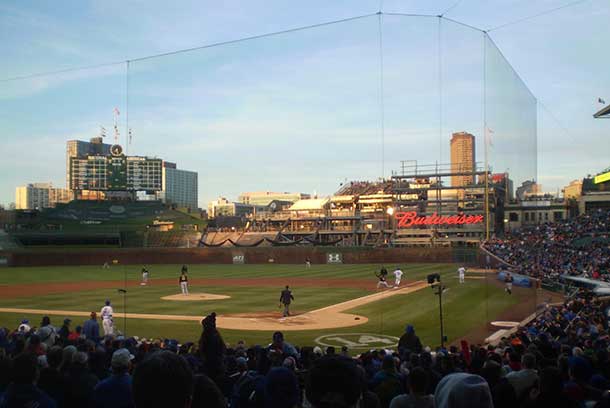
While Wrigley’s intimate red brick walls provide a Christmas time accent to the loveliness of Wrigley’s natural green grass. While its mammoth scoreboard rises majestically high, dead centre, like something from the Great Wall of China. A mighty emerald architectural creation in a park that’s stood for a hundred years.
Wrigley, named after the famous spearmint chewing gum makers, is the United States second oldest ballpark next to Fenway in Boston.
Only last winter my wife, Margaret, and our son, Galen, were walking Wrigley’s snowbound neighbourhood. There were winter signs of cheer and goodwill inviting Cubs fans to return in the spring. A large snowman constructed of nothing but a conglomerate of white baseballs stood by the Will-call windows.
When our son stepped back to take photos from a wider perspective, Margaret motioned a gentle foot across snow dusted red bricks planted in the approach to Wrigley. With the endless saga of Chicago’s Cubs never having won a World Series what was revealed may, in fact turn out to be providential. For every brick was assembled with a donation from hopeful, faithful North side patrons. Clearing excess snow from this one the phrase printed on it read, “This could be the year, dad!” What we’re the odds of discovering that one among the hundreds of others!
Well the symbolic ivy at Wrigley was initially planted in 1937 by Bill Vick. His father was the Cub’s former president. Bill Veeck’s idea is said to have come from a field he once saw covered in ivy in Indiana. As there were renovations taking place that year, especially in the bleachers, it was a nice aesthetic touch to spruce up the confines with a gardener’s parthenocissus tricuspidata commonly called Boston ivy. Sometimes called Japanese creeper or grape ivy.
The work was accomplished with long hours of work by the nearby Clayvey Greenhouse. They understood what they were up against and succeeded in draping Wrigley with such a fine accent of greenery.
To be truthful one’s first reaction walking into Wrigley, and then down the slope to box seats, is an impression that this abundant ivy is as thick and wonderfully rich as English hedges in places like Victoria, B.C.
Like all idiosyncratic sports complexes Wrigley’s ivy has been both a blessing and a hex. A blessing when an opposing outfielder is totally befuddled when a long distance ball does not
ricochet cleanly. Has stuck itself in the tangly growth and through the overlap of leafage has disappeared from sight.
Wrigley’s pre-game meeting of managers and umps includes scenes of gesturing and obviously discussing an issue like this. On the other hand a hometown player named Jose Cardinal was not to be outdone by the ivy’s mystique. He took an extra baseball to the outfield, on an innings exchange, determined to set a ball in a stash in case a hitter hit one he couldn’t find. This might have sponsored his Houdini moment eventually but he was eventually caught by a bleacher’s cameraman and Cardinal’s jig was up.
But the ivy wall has other stories. Darryl Strawberry, of the New York Mets, playing there for the
first time–without understanding there was a massive perimeter of brick overlapped by ivy- actually smashed through a facade of ivy chasing a fly. Strawberry looking up anticipating the trajectory of the ball was running at full force. He was stopped cold. Dazed. Had to be assisted off the field. “No told me about that,” Strawberry said hobbling back to the dugout.
Cub fans you meet have various other tales through the ages. One told of Enos Slaughter finding a little nesting place way out beyond the warning track where he put his pouch of snuff.
And so days before going to Wrigley I kept imagining that it would be neat writing about a baseball getting out to the ivy in– whatever way leaving its lasting impression on our tour. It was a thought that travelled with me to the point I simply felt at least a single baseball would get hung on the wall?
More later.
In driving to the park the notion of where to park is supreme. With the unique-ness of having such a mammoth structure that’s the absolute focal point dominating where it is, parking lot vendors have signs from $30 to $40. Yet, their prime time spots are readily bought up and those riding in cars spill out right away gleefully anticipating a traditional game with the Cubbies. Highlighted with their peanuts and Cracker Jack 7th inning stretch home song. Cracker Jack, in fact, made its audition in Chicago at the World’s Fair being held there in 1893.
But Ed, a faithful Cubs fan living in the area, told of a playoff series where everything around Wrigley was nothing but parking congestion. “Swarming like bees with cars and people, he began telling. He continued, “As Walt Whitman once said, of overcrowding, ‘it would seem every square inch becomes a little miracle.’ ”
“So,” said Ed, “my roommate and I made a sign for Parking. Put it right outside our apartment. We were quite close to all the entrances at Wrigley. Though never suspecting who might arrive, caught very late in jammed intersections on the way?”
“It was–to remain nameless,” Ed said quietly, almost in a Shakespearean aside to his story, “One of the Cubs coaches. Imagine. One of those days where everything is just topsy-turvy.”
It turned out over zealous fans had double-parked by the coaches and managers spots. Creating a log jam. Tipsy-turvy indeed.
Ed went on, “it was somehow in our cards. He turned out to be a fascinating visitor. Came back after the game. Came up for a beverage, as well, and we all talked Chicago baseball until well after midnight.”
Another Wrigley parking story came about when both Willie Mays, of San Francisco, and a hometown Cubbie hit home run shots that soared out both hitting the same car and smashing windows.
“The amazing bit of that matinee game, back in time,” said one called Larry, was the owner was actually in the car. He got to Wrigley okay. Found a place to park. But couldn’t get a ticket to get in. He was found in the car listening to the game of radio.”
Relying on music as with the Mumfords’ song introducing the climbing, crashing into walls; another tune about Wrigley was written by Eddie Vedder (of Pearl Jam) being born in Illinois.
Vedder’s song called All The Way immortalizes the ivy and Cubs Hall of Fame shortstop Ernie Banks.
When you are born in Chicago you’re blessed,
The first time you walk in to Wrigley
Our heroes are in blue.
We are one with the Cubs
There’s magic in the ivy and the old scoreboard;
Ernie Banks said, “Oh, let’s play two,”
Did he mean 200 years?
Yeah, someday…we’ll go all the way.
Then, I’ll look to the sky and know I was right!
At our game the Cubbies were getting off to an early offensive start. They stacked up runs against the Pittsburgh Pirates. Rookie Chris Bryant, a third baseman, had a terrific night.
Good with the bat. Running bases. And scoring. But particularly neat on defense.
His length sponsored a highlight reel. Bryant took a throw, with a Pirate straying off third.
He stretched–his arm extended–to make a put out others might not have been able to make.
The runner was as surprised as the umpire. For it took a replay to confirm the magnificent pace of it all. The crowd of 29, 991 rose to a standing O. Bryant nodded, touching his cap. The Cubs jogged smartly into their dugout. They would win 6-2. Lefty Travis Wood the victor. The crowd sang their theme song and Wrigley rocked on well up to midnight.
Though the sight of the only home run ball, tallied by Pittsburgh, was still contrasted like a little moon caught up in netting right over the ivy of left field. It was suspended without anyone to field it as Wrigley is again going through a retro fit. The trapped ball seemed as a metaphor for the times.
When the Veeck family were pioneering their designs with the ivy that ball would not have rolled into a security net. In those decades it would have dropped back to the field. Where, likely, the Cubs left fielder would have flipped to a fan. Tossing it gently back up over the Ivy. A Major League souvenir with a story wrapped around it. A thrill. A joy for those who’d catch it.
Here, as work crews got out to tidy up the field for next time. A baseball, which is the true object of every pitch through every inning of a game, would just be there. In limbo. All 5 1/2 ounces with some 235 red stitches formerly hand crafted, through time, in Chickopee, Massachusetts. Now seeming so far removed from its makers. As Wrigley’s lights were dimmed its metaphoric meaning, and its value in seeing it go out, upheld merely in the inning in which it will be scored as a four-bagger in the Chicago Tribune’s morning edition.



